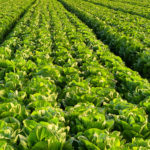Growing the best, most profitable produce on the market isn’t easy. Whether you are growing carrots, onions, potatoes, sugar beets or sweet potatoes, there are specific nutritional tools and information that can help you consistently operate at the highest level.
At Agro-K, we concentrate on the Five R’s: Growers achieve the best results when they use the Right nutrient applied at the Right time in the Right formulation in the Right mix targeting the Right place in the plant. Science-Driven nutrition offers root crop growers the program and the tools to accurately and effectively address their crop’s specific needs, while minimizing product waste. By taking an analytical approach, Agro-K focuses on an operation’s most important key metrics. Then, using Science-Driven tools, growers can manage their crop more effectively and profitably. The Five Rs help growers achieve consistent success and an elevated economic performance.
Because each root crop is unique, we’ve divided this category into carrots, onions, potatoes, sugar beets and sweet potatoes. Click the link for the relevant crop to go directly to that section below.
RESOURCES

Carrot crops are unique in that the right size, length, width and shape all depend on the variety grown and the market being targeted. While most growers primarily focus on the fresh market, some carrot crops go to processors. Growing an intense, high-color carrot is very appealing to consumers, who buy with their eyes. When this strong color is combined with a great eating experience that is exemplified by texture and flavor, carrot growers increase the marketability and sales potential for their carrot crop.
From size and shape to color, texture and flavor, a carrot crop’s most important attributes can benefit significantly from science-based nutrition. Agro-K’s Five R-driven programs not only help growers achieve consistently delicious, strong-colored carrots, they also increase the carrot’s shelf-life in the grocery store and in the consumer’s home.
Because grocery store buyers and managers evaluate shrink very intensely, the Five R’s become particularly important for combatting it. These nutritional programs and tools also have a positive impact on the carrot’s food value and nutrient density. The specific tools may differ depending on whether the carrots are being grown conventionally or organically, but Agro-K has specialized programs for both conventional and organic crops that can be adjusted accordingly. Each program is designed to help growers achieve the desired size and shape for various carrot varieties.
Both programs follow the Five R’s. Conventional carrot crops require four applications.
- Early rosette: Apply Sysstem® Leaf Max at 1-1.5 pints per acre.
- Carrot extension and lengthening: Apply Sysstem® Leaf Max at 1.5 pints per acre. This application should be combined with Vigor-SeaCal™ at 2 quarts per acre and Agrobest® 9-24-3 at 2 pints per acre.
- Carrot thickening: This will mirror the second. Sysstem® Leaf Max at 1.5 pints per acre, with Vigor-SeaCal™ at 2 quarts per acre and Agrobest® 0-20-26 at 2 pints per acre.
- Maximizing carrot sugar, flavor, color and uniform maturity at harvest: Apply Ultra Finish DL™ at 2-4 quarts per acre.
Organic carrot crops follow a similar application schedule with a different toolkit of certified organic products and solutions.
- Early rosette: Apply CLEAN Micro-Mix® at 1-2 pints per acre.
- Carrot extension and lengthening: Apply CLEAN Micro-Mix® at 1-2 pints per acre a second time. This application should be combined with CLEAN SeaCal® at 2 quarts per acre.
- Carrot thickening: Apply CLEAN Micro-Mix® at 1-2 pints per acre with CLEAN SeaCal® at 2 quarts per acre and CLEAN Potassium 0-0-6 ® at 1 gallon per acre.
- Maximizing carrot sugar, flavor, color and uniform maturity at harvest: Apply CLEAN Potassium 0-0-6® at 1 gallon per acre.

Onion growers know that their crop is a popular one. While the fresh market onions go to grocery stores, there are also the onions used by food service companies and restaurants. Not to mention the dehydrators and seed suppliers that also use onions in their product lines. The onion is a diverse, flexible and complicated crop: Depending on the end customer, onions need to exhibit various bulb sizes and other desired qualities.
Thankfully, growers can manipulate bulb size, weight, flavor, storability and shelf-life, and increase single centers using proper nutrition. The right science-backed programs and information can also reduce disease pressure and strengthen an onion’s notoriously weak root system. For this, Agro-K helps growers implement the Five R’s.
With onions, the right formulation is extremely important. Onions have a small, thin, very waxy leaf that is incredibly difficult to penetrate; therefore, nutrient formulation will dictate performance. The most expensive nutrients are the ones that don’t work. If a product is in the wrong form, it won’t go in, nor be useable by the plant.
The right formulation will have a low pH, a small molecular size and high solubility. When it comes to strengthening the roots, it’s important for growers to use formulations with zinc and manganese phosphite – these components will increase root mass, compensating for normally weak onion root systems.
One of the great things about onion crops is that there are ample opportunities to use free-ride applications to utilize foliar nutrition. Examples of this include fungicides, insecticides and miticide applications. There are a few key times onion growers will want to target to maximize the success of their nutritional program.
- Early leaf and root development: Applications of zinc, manganese, magnesium, copper, iron and phosphate are particularly important. These are the nutrients that are essential for good leaf and root development and size, as well as chlorophyll development in the leaves.
- Onion bulb initiation: Applications of calcium and phosphate are vital for bulb size, weight, texture/slicing and storability.
- Bulb bulking: This is the time for adding potassium, while maintaining calcium in the bulb and chlorophyll nutrients in the leaves. The rates and the intensity of the potassium and later sprays will influence bulb size and grade.

For as many ways as there is to cook a potato, there are just as many ways to grow them. Farmers who focus on the fresh market have cropping targets that include bakers, boilers/steamers and the relative newcomer, fingerlings. Those who target the processors grow potatoes for French fries, as well as spuds that will be scalloped, sliced and dehydrated (aka buds, which will be used for mashed potatoes and other intensely processed potato products for restaurants, institutional use and households). Then there are the potatoes strictly grown for seed. Each category can then be divided into two more: conventional and organic.
Each target market has its own version of what the right potato looks like. In the fresh market category, marketability is very dependent on potatoes that have the right size and grade. The bakers must have a clean interior quality as exemplified by appropriate flesh color, flesh texture, lack of internal discoloration, no hollow heart, and appropriate skin texture and skin set.
The boiler/steamer category is similar to that of the bakers, but these spuds tend to have thinner, more sensitive skins that need to be protected. Every grower must produce potatoes with a good skin set and the right skin color particular to the variety of potato. Size is also very important, and it must match with how the consumer cooks and eats the potato. All the fresh market potatoes need to be able to be stored for a reasonable length of time. They also need to have appropriate flavor to go with the texture of the flesh.
In the processor category, growers need to be mindful of the processor’s specific size and grade requirements. Growers who do not meet these size and grade requirements may be penalized by the processor, but the farmers who meet and go above these specifics can earn premiums. These details include specific gravity or density of the potato, clean internal quality, appropriate sugar levels, and storability. In some cases, flesh color is also important.
Seed potatoes have key quality requirements as well. This category centers on the tuber size, tuber shape, energy or carbohydrate levels in the tuber, and the number and location of eyes on the tuber. Regardless of where a grower’s potatoes end up, the appropriate qualities can be directly and positively impacted by Science-Driven, Five-R nutrition.
Conventional potato crops require specific applications.
- Rosette: Apply Sysstem® Leaf Max at 2 to 3 quarts per acre.
- Row close: Apply Sysstem® Leaf Max at 2 to 3 quarts per acre a second time.
- Tuber bulking/heat stress: Apply UltraFinish® Potassium at 1 gallon per acre.
- Vine preservation and extension for best crop finish: Apply MicroMix DL® at 2 quarts per acre and repeat the application if needed.
Organic potato crops follow a similar application timetable but require different products and solutions.
- Rosette: Apply CLEAN Micro-Mix® at 3 quarts per acre.
- Row close: Do a second application of CLEAN Micro-Mix® at 3 quarts per acre.
- Tuber bulking/heat stress: Apply CLEAN Potassium 0-0-6® at 1 gallon per acre, and this application occurs at tuber bulking and summer heat. Growers must repeat this application a second time 7-14 days after the first. This will be the fourth application.
- Vine preservation and extension for best crop finish: Apply CLEAN Micro-Mix® at 2 quarts per acre and repeat the application 7-14 days later.

When it comes to producing sugar beets, increased tonnage and high sugar content are the top priorities. The right nutritional program can maximize both. The production of large sugar beets with the highest sugar content are based on maximizing photosynthesis. Photosynthesis is heavily impacted by strong early leaf development and large leaf size, as well as having great chlorophyll in those leaves. Growers will want to start by taking soil and sap tests, as well as a post-harvest analysis of sugar production, to see a report card of how well their nutritional program performed and a roadmap for future seasons.
Armed with the right science-backed nutritional info and tools, growers can make the best choices for their sugar beet crop. The Five R’s make this possible. When it comes to sugar beets, the focus centers on the right nutrient at the right time and in the right formulation. This means taking advantage of free-ride tank mixes to make early applications of key nutrients.
Agro-K’s Sysstem Ready®, which combines zinc and manganese phosphite, can be mixed and applied with applications of Roundup (glyphosate) during peak demand for chlorophyll development. This foliar nutrient formulation is the only one with university trial data and grower data supporting the increased yield benefit of a zinc-and-manganese-phosphite formulation mixed with Roundup. It can be applied once or twice as needed with Roundup applications in sugar beets.
It is essential that zinc and manganese applications coincide with Roundup applications. Otherwise, the zinc and manganese will be tied up and chelated by the Roundup and unavailable for nutrient value for the plant or, at high enough rates, the nutrients will deactivate and antagonize the Roundup. The phosphite form used in Sysstem Ready® prevents this from occurring.
The next step is to apply potassium during the sugar beet bulking window to increase beet size, sugar production and sugar transport. At the start of peak sugar development, growers should apply Agro-K’s Top Set DL®, a premix combination of boric acid plus molybdenum.
This sequence – starting early with the Sysstem Ready® and Roundup, followed by potassium at beet bulking and Top Set DL® at the start of peak sugar development – has consistently shown to increase sugar production and beet tonnage. Growers will appreciate that this sequence of nutritional inputs is also more cost effective because it can be accomplished while using free-ride tank mixes with other sprays like Roundup, fungicides or insecticides.

Sweet potato operations are focused on one thing: growing as many USDA number ones as possible. The main challenge is skin quality. Farmers want a crop that is strong, healthy and resistant to skinning at harvest. Success comes from implementing the right Science-Driven nutrition program.
Compared to its root crop counterparts, the sweet potato tends to be a little bit more relaxed. Growers have a decent amount of time to set, grow and harvest their crop. But those that want to get to 400 or more bushels of sweet potatoes per crop must focus on root health, skin quality, size, uniform maturity at harvest and storability. All of these desirable qualities can be maximized with by following Agro-K’s Five R’s.
The process begins by analyzing the soil, tissue and sap, and the results guide farmers in two ways: a nutritional report card for the current season and a nutritional roadmap for the future. Armed with an operation’s test results, Agro-K helps growers focus on the nutrients that matter most: phosphate, calcium, potassium/potash, and nitrogen.
The phosphate is most important for root development and growth. Once sweet potato farmers set their slips, the crop needs adequate moisture. Applications of phosphate combined with a biostimulant help give the slip the punch it needs to overcome environmental challenges and grow. With the development of vines, sweet potatoes require a mix of potash and nitrogen to size them up. These nutrients can be applied with other sprays, as sweet potatoes often require additional care to keep insects, rot and other issues at bay.
As the sweet potato grows, calcium becomes essential to improve skin quality and hardiness. This can be difficult to apply, as the crop is underneath the soil. The right formulation of calcium ensures the crop can use the nutrient to develop a good, thick skin quality.
Agro-K understands the importance of these nutrients in high quality formulations to help growers consistently achieve high-quality, strong-skinned, dense sweet potatoes. We know when, where and how to best apply these formulations, empowering growers to focus on the intricacies of managing their operation.



